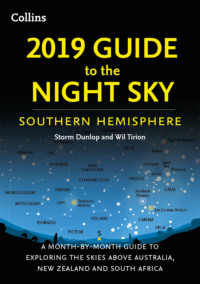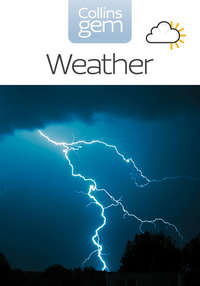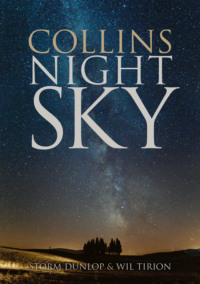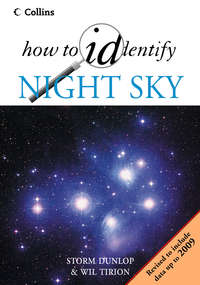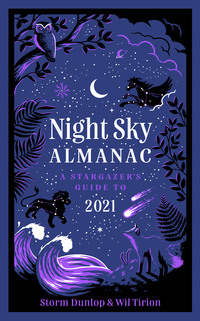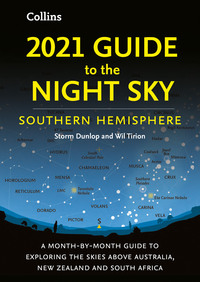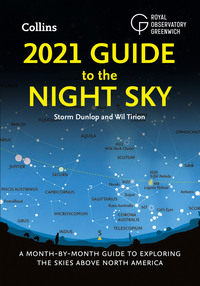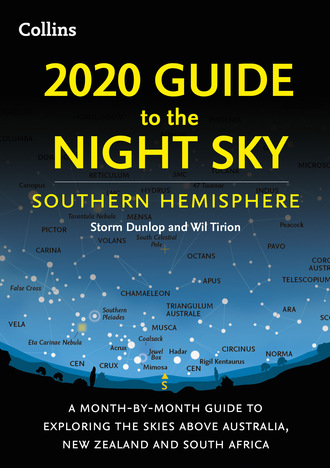
Полная версия
2020 Guide to the Night Sky Southern Hemisphere

Meteor shower (showing the Geminids radiant).

Measuring angles in the sky.
Some interesting objects.
Messier / NGC Name Type Constellation Maps (months) — 47 Tucanae globular cluster Tucana All year — Hyades open cluster Taurus Oct. – Feb. — Melotte 111 (Coma Cluster) open cluster Coma Berenices Mar. – Jun. M3 — globular cluster Canes Venatici Mar. – Jul. M4 — globular cluster Scorpius Mar. – Sep. M8 Lagoon Nebula gaseous nebula Sagittarius Apr. – Oct. M11 Wild Duck Cluster open cluster Scutum May – Oct. M13 Hercules Cluster globular cluster Hercules May – Aug. M15 — globular cluster Pegasus Jul. – Nov. M22 — globular cluster Sagittarius Apr. – Oct. M27 Dumbbell Nebula planetary nebula Vulpecula Jun. – Oct. M31 Andromeda Galaxy galaxy Andromeda Sep. – Dec. M35 — open cluster Gemini Nov. – Mar. M42 Orion Nebula gaseous nebula Orion Oct. – Apr. M44 Praesepe open cluster Cancer Dec. – Apr. M45 Pleiades open cluster Taurus Oct. – Feb. M57 Ring Nebula planetary nebula Lyra Jun. – Sep. M67 — open cluster Cancer Dec. – May IC 2602 Southern Pleiades open cluster Carina All year NGC 2070 Tarantula Nebula emission nebula Dorado (LMC) All year NGC 3242 Ghost of Jupiter planetary nebula Hydra Jan. – Jun. NGC 3372 Eta Carinae Nebula gaseous nebula Carina All year NGC 4755 Jewel Box open cluster Crux All year NGC 5139 Omega Centauri globular cluster Centaurus Jan. – Sep.The Southern Circumpolar Constellations
The southern circumpolar constellations are the key to to starting to identify the constellations. For anyone in the southern hemisphere they are visible at any time of the year, and nearly everyone is familiar with the striking pattern of four stars that make up the constelllation of Crux (the Southern Cross), and also the two nearby bright stars Rigil Kentaurus and Hadar (α and β Centauri respectively). This pattern of stars is visible throughout the year for most observers, although for observers farther north, the stars may become difficult to see, low on the horizon in the southern spring, espcially in the months of October and November.
Crux
The distinctive shape of the constellation of Crux is usually easy to identify although some people (especially northerners unused to the southern sky) may wrongly identify the slightly larger False Cross, formed by the stars Aspidiske and Avior (ι and ε Carinae respectively) plus Markeb and Alsephina (κ and δ Velorum). The dark patch of the Coalsack (a dark cloud of obscuring dust) is readily visible on the eastern side of Crux between Acrux and Mimosa (α and β Crucis).

A line through Gacrux (γ Crucis) and Acrux (α Crucis) points approximately in the direction of the South Celestial Pole, crossing the faint constellations of Musca and Chamaeleon. Although there is no bright star close to the South Celestial Pole (and even the constellation in which it lies, Octans, is faint), an idea of its location helps to identify the region of sky that is always visible. (The altitude of the South Celestial Pole is equal to the observer’s latitude south of the equator.) The basic triangular shape of Octans itself is best found by extending a line from Peacock (α Pavonis) through β Pavonis, by about the same distance as that between the stars.
Centaurus
Although Crux is a distinctive shape, Centaurus is a large, rather straggling constellation, with one notable object, the giant, bright globular cluster Omega Centauri (the brightest globular in the sky), which lies towards the north, on the line from Hadar (β Centauri), through ε Centauri. Rather than locating the South Celestial Pole from Crux, a better indication is the line, at right angles to the line between Hadar and Rigil Kentaurus that passes across the brightest star in Circinus (α).
Carina
Apart from the two stars that form part of the False Cross, the constellation of Carina is, like Centaurus, a large, sprawling constellation. It contains one striking open cluster, the Southern Pleiades, and a remarkable emission nebula, the Eta Carinae Nebula. The second brightest star in the sky (after Sirius) is Canopus, α Carinae, which lies far away to the west.
The Magellanic Clouds
On the opposite side of the South Celestial Pole to Crux and Centaurus lie the two Magellanic Clouds. The Small Magellanic Cloud (SMC) lies to one side of the relatively inconspicuous, triangular constellation of Hydrus, but is actually within the constellation of Tucana. Nearby is another bright globular cluster, 47 Tucanae. Hydrus itself is also easily identified from the star, Achernar, α Eridani, the rather isolated brilliant star at the southern end of Eridanus, which wanders a long way south, having begun at the foot of Orion.

The stars and constellations inside the circle are always above the horizon, seen from from latitude 35°S.
The Large Magellanic Cloud (LMC) lies within the faint constellation of Dorado. Not only is it a large satellite galaxy of the Milky Way Galaxy, but it contains the large, readily visible, Tarantula Nebula, an emission nebula that is a major star-forming region.
Конец ознакомительного фрагмента.
Текст предоставлен ООО «ЛитРес».
Прочитайте эту книгу целиком, купив полную легальную версию на ЛитРес.
Безопасно оплатить книгу можно банковской картой Visa, MasterCard, Maestro, со счета мобильного телефона, с платежного терминала, в салоне МТС или Связной, через PayPal, WebMoney, Яндекс.Деньги, QIWI Кошелек, бонусными картами или другим удобным Вам способом.




